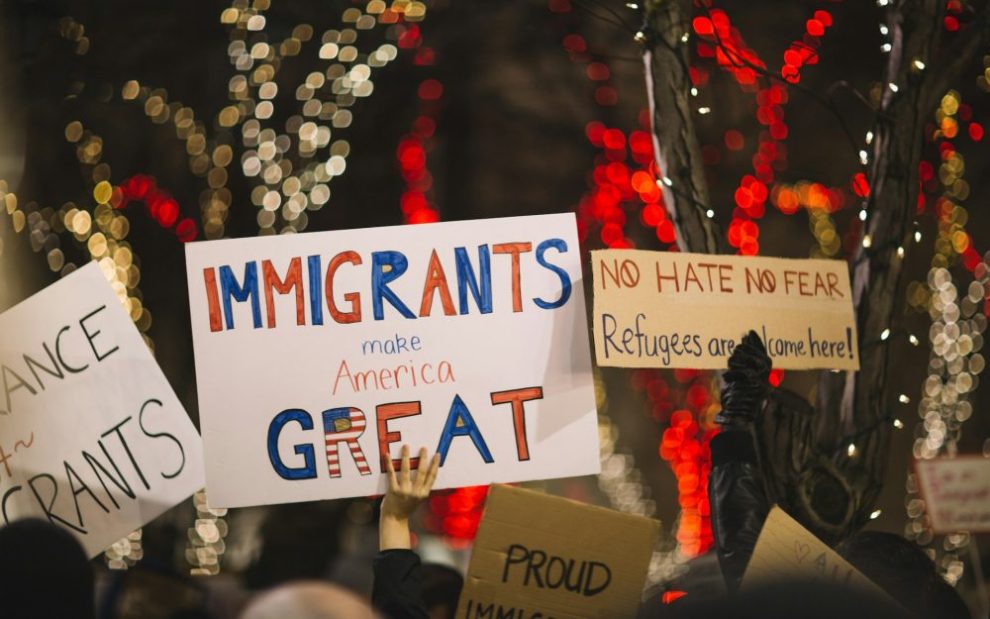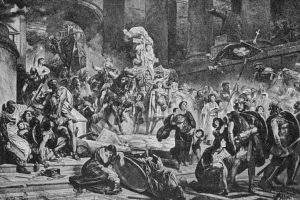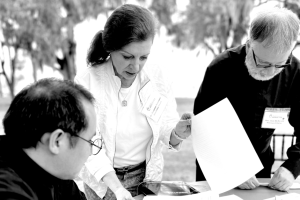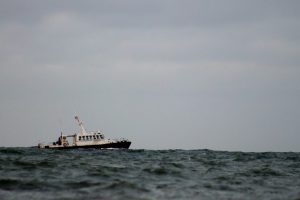On Tuesday, September 9, residents of Rochester, New York showed up en masse at a neighborhood home where immigration enforcement officers had detained a roofing worker and were attempting to detain more of the roofers working on the house. Word got out to the community, and locals started arriving to form a human chain around the house and drive out ICE.
The pressure from community members who showed up that day—which totaled about 200 people—put enough pressure on ICE that they left, and no further arrests were made.
Rev. Myra Brown, the pastor of Spiritus Christi Church, was present at the action. She spoke with U.S. Catholic about how the Rochester community stood up to ICE, why her faith compelled her to be there, and how other communities across the United States can protect immigrants and resist ICE.
Can you say a bit about yourself and your church?
I’m the pastor of Spiritus Christi church in Rochester, an independent Catholic church that separated from the Roman Catholic diocese in 1998 over justice issues. Our congregation has been standing for justice for a very long time—with the poor, the vulnerable, and people who are left out and marginalized: women, LGBTQIA+ folks, Protestants who aren’t allowed to take communion in the Roman Catholic church. We believe that our call is to follow Jesus in a radical message of unconditional love, which means sometimes breaking rules that counter that.
We have been preparing for this administration to begin targeting new Americans. There were some early signals with Project 2025 of whom the targets would be, so we started planning for the potential that ICE would come to our city and try to detain and take people.
We started meeting with and reaching out to immigration rights organizations in November 2024. We brought other churches and people together because we needed to know what our rights were and how we could come together and strategize and think about if a scenario happened, what do we do? We’ve been able to talk with immigration lawyers, organizations, and nonprofits that are servicing people from Latin American countries and who are asylum seekers and refugees.
We as a church have a program called Speaking from the Heart, where we have serviced and walked with folks who are undocumented but are in the process of becoming U.S. citizens. So, we did have a dog in this fight. We needed to make sure that we can continue to do our programming and have people feel safe in those spaces, and for people to trust us to keep them protected.
How did you hear about the immigrant roofers who were being targeted?
Last Tuesday (September 9), the day that we got the call, was that moment we had been planning for. In all of those trainings we had, we talked about the need to have a rapid response team if ICE showed up on the scene. We talked about the need to show up en masse to make sure that we were larger than the effort that ICE was putting forth to take people.
I got the call that day; it was one of the busiest days in our church. My calendar was fairly loaded. We were preparing to go into our admin meeting when my phone started going off. I was trying to finish my sentence, so I ignored it. Then the call went to Lauren, my hospitality minister, who does some operations and youth ministry, and she answered. It was an organizer we’ve been working with around immigration. She said, “ICE is here, they’ve taken somebody off the roof. They are trying to take three roofers. We need you to come now and bring as many people with you as you can. We need to create a human chain.”
We dropped everything and jumped in the car—myself, Lauren, and Aaron, my AV manager. We went to the address that they’d given us. There were probably about 20 to 30 people there. Visually, I knew that was not enough. On the way there, Lauren and I started calling people we knew to get more people to show up to this protest to try to keep the roofers safe.
How did you get that many people involved in the protest?
When we got there, I went over to one of the organizers who had called us and asked if we could go live [on social media]. I’d learned from the 2020 protests that going live on Facebook when you have a number of Facebook friends—and I have close to 5,000—is the quickest way to speak directly to people and invite them to join us. Once they gave us that permission and said we could go live, I took to my Facebook page. I went live and asked people to come. I told them that we needed their help and that we needed to keep the roofers safe. It was a concerted effort, and it worked.
As people were pouring in, I started to walk up the driveway toward the fire escape so that we could provide some human chain protection for the gentlemen who were on the roof. And almost immediately, one of the ICE agents tried to stop us. He said, “We’re going to need you guys to stay on the sidewalk,” which is quite a ways from the fire escape where the roofers were.
But I had been trained since November, and I knew that they couldn’t bully me like that. So I said, “No, we don’t have to get on the sidewalk. This is private property. You don’t own this property. The owners have not asked us to leave, and you’re actually standing on another owner’s private property that you don’t own. We don’t actually have to stay on the sidewalk.” So we proceeded to stay close to the house where the roofers were.
The ICE agents started getting a little nervous, and they started hiding behind bushes. One of them had a mask on; he didn’t want his face to be seen. Protesters, as they continued to pour in, began to take pictures and post them. Apparently, ICE agents work on anonymity; somehow, that serves them, not sure how. But they continued to hide behind the bushes to avoid having their pictures taken or videotaped.
But people in Rochester continued to pour in. We’re the home of Susan B. Anthony and Frederick Douglass. It’s in our blood in Rochester to fight for justice, to stand with people who are marginalized. I was so proud. Many of our parishioners started to pour in. They got that message on Facebook, and they showed up strong.
More than 200 people eventually showed up. It was a great force of folks to send a very strong message to ICE that we were not going to stand down, and we’re not going to allow them to just come in and start taking people, without our putting our own bodies on the line.
How did the community succeed in driving ICE out of the neighborhood?
Everybody had their role to play. One of the organizers was talking to ICE, and she discovered that they did not have an administrative warrant. They had no warrant signed for those gentlemen. They were literally just using intimidation and bullying tactics to take them away.
She was doing her role, challenging that. We were doing our role, being a visual force of resistance. Eventually, she was able to convince them that we weren’t going anywhere and that we probably would not be letting them take the roofers. I think they tried to activate some kind of police, but that didn’t work because we’re a sanctuary city. Our local police are not allowed to help ICE do their job.
ICE finally gave up and agreed to leave. There was thunderous applause. Of course, there’s always people who are angry—and rightfully so—who are shouting, “Na na na na, hey, hey, hey, goodbye,” and those kinds of celebratory chants. And chants just saying, “Go home, get out of here. We don’t want you here in Rochester.” We were absolutely delighted. The roofers are husbands and sons and brothers and uncles who were just trying to make a living putting on a roof. They should not be harassed by ICE in that way.
One of the things that’s been a pattern across the country is for ICE agents to plant people in the protest. We discovered after, as they were leaving, that their vehicle tires were slashed. We believe that it was a person they’d planted that slashed their tires to attempt to put that on the protesters. One of my staffers saw a gentleman who looked like he was suspiciously cutting those tires. He was not part of our protests. In fact, he is a strong supporter of the Trump administration and the taking of immigrants and refugees.
We believe it’s possible that he was the person who slashed those tires. He put up a Facebook post with false accusations, saying that protesters were fighting ICE and slashing tires. There were no protesters physically fighting ICE.
Anyway, it didn’t work, whatever his scheme was. The community won that day.
As a pastor and person of faith, why was it important to be there?
When I was ordained, the scripture for my ordination as a priest was from Micah 6:8: “What does the Lord require of you? To do justice, to love kindness and to walk humbly with God.” I try to live by that in the work that we do at the church, and we call our community and staff to that work.
Rochester has been a hub for people answering that call. We’ll show up for justice. We’ll show up for kindness. We’ll show up to walk humbly with God in whatever way God needs us. We believe that God needed us that day. So we showed up.
The invitation for pastors and Christians is to follow Jesus. Those are the most powerful words that Jesus gave us: to follow him. When you ask yourself, What does it mean to follow Jesus? How did Jesus live his life? Jesus stood up for the poor. He took on political leaders who left them destitute, who left them afraid, who left them intimidated.
Jesus put his own body, his own life, on the line for the poor and for the marginalized and people who had less power than empire and systems. That’s what it means for us as Christians to follow Jesus, to take up our cross and to follow him, to count the cost of justice. And to trust that God will give us what we need in those moments. We don’t know if we’re going to win some or lose some in those moments. But what we do know is that we follow Jesus. His journey took him to the cross, on behalf of the people. Sometimes our journey will take us to our cross.
In this moment, I think this is our cross to bear. This is our Calvary, where the threats lie, where the possibilities of bodily harm lie, where families are being destroyed and violated and harmed. Jesus was an activist. He was a youth minister; those disciples were teenagers. He used youthful mindsets of those willing to take a chance on re-imagining a different kind of world where there’s a place for everybody. That’s the invitation we’ve been given. I could not not be present for that opportunity to stand with Jesus and the poor.
How have people in Rochester and beyond reacted to the protest?
I think it’s injected a lot of hope into this community. We’ve been inundated with emails, messages on social media, and texts from people in Rhode Island and Texas and North Carolina, people that I’ve never met before.
We’ve gotten voicemails from people weeping and crying on the phone, just saying, “Thank you, thank you, thank you. I felt so hopeless, and I came across the story of your community standing up to ICE. You’ve given us hope again.”
Sometimes the stars shine the brightest when it gets the darkest. I think we have given people hope that together we hold our own power to push back against injustice.
We have the power to shift the narrative and not fall into these schemes from a government that has decided to target people based on race and language, and not even allow them to finish a process that we’ve invited them into. These are not criminals. These are not murderers. This administration is using a narrative to throw us off so we lose sight of each other’s humanity.
We can never do that. We are in this together. No matter what the faulty narratives are, no matter how people are wielding power, together, we are more powerful than we are alone.
What advice would you give those who want to do the same in their own neighborhoods, churches, and communities?
Reach out to organizations that are building resistance and find your narrative. For our movement in Rochester, our mantra is that we are “Standing ROC Solid”— Rochester solid. We’ve created a logo to that effect, but I think every city can stand rock solid.
We all know the story of when Jesus is baptized and he goes into the desert, led by the Holy Spirit. There, Satan says to Jesus, “Bow down to me and I will give you the wealth and the riches of the world.” We can never bow down. Jesus didn’t do that.
We can’t bow down to power and be lured by promises of self-interest. We don’t need worldly treasures because the people are the treasure. We’re always treasures to one another, and we can never forget that.
This is a pivotal moment that is going to define where we go in our future; whether we stand up or fall down. We have the power to stand up and stand strong and live into our values and principles as deeply as we can.
This is our moment of conviction, to stand rock solid on those convictions. That’s what we’re going to do here in Rochester.
Image: Unsplash/Nitish Meena













Add comment